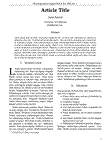Resultados de búsqueda - (("nada" OR (("nair" OR "naire") OR "naire")) OR ("jair" OR "aire"))
Materias dentro de su búsqueda.
Materias dentro de su búsqueda.
- Innovación 2
- NOx 2
- Tampico 2
- aire 2
- contaminación 2
- contaminación del aire 2
- contaminantes 2
- sustentabilidad 2
- television 2
- televisión 2
- , COVID-19 pandemic 1
- 19 de septiembre de 1985 1
- 3D-printing 1
- Académico 1
- Administración Pública 1
- Administración de la Cadena de Suministros 1
- Aeromexico 1
- Aeroméxico 1
- AgSb(S,Se)2 1
- Almudena Grandes 1
- American chains 1
- Amino acids 1
- Análisis 1
- Aquaculture 1
- Archivo 1
- Arco eléctrico 1
- Argentina 1
- Armazones organometálicos 1
- Arquitectura tradicional 1
- Arte 1
-
181
-
182
Presencia de la medicina en las novelas del mago Harry Potter
Publicado 2007Enlace del recurso
Artículo -
183
-
184
Semiconductor thin films by chemical bath deposition for solar energy related applications.
Publicado 1998“…The effect of annealing the films in air on their structure and composition and on the electrical properties is notable: CdS and ZnS films become conductive through a partial conversion to oxide phase; CdSe becomes photosensitive, SnS converts to SnO2 , etc. …”
Enlace del recurso
Artículo -
185
-
186
-
187
-
188
Alpha-synucleina potencia la toxicidad de oligomeros de tau en células de neuroblastoma.
Publicado 2019Enlace del recurso
Conferencia o artículo de un taller. -
189
-
190
-
191
Las Brujas de la Noche: el regimiento aéreo femenino de la Segunda Guerra Mundial
Publicado 2024“…The Night Witches: The All-Female Air Regiment Of World War II…”
Enlace del recurso
Artículo -
192
UDP-glucosa esterol glucosiltransferasas como blanco para aumentar la producción de esteroles bioactivos en planta.
Publicado 2019Enlace del recurso
Conferencia o artículo de un taller. -
193
La medicina y la enfermedad en Alfonso Reyes
Publicado 2009“…Algunas de las enfermedades que sufrió Alfonso Reyes influyeron en su creación literaria, y su condición de enfermo constante lo llevó a reflexiones nada casuales, siendo un ejemplar paciente. Abstract: In this essay, the symptoms, diseases and therapies that the Mexican writer Alfonso Reyes suffered are analyzed. …”
Enlace del recurso
Artículo -
194
Internacionalización en el sector aéreo de América Latina: estudio multicaso de Aeroméxico, Avianca y Latam
Publicado 2018“…Internationalization in the Latin American air sector: multicase study of Aeromexico, Avianca and Latam…”
Enlace del recurso
Artículo -
195
La lucha contra la contaminación atmosférica: el caso de las pedreras en los cerros Las Mitras y el Topo Chico, 1970-2015
Publicado 2023“…The Fight Against Air Pollution: The Case Of The Quarry In The Las Mitras And Topo Chico Hills, 1970-2015…”
Enlace del recurso
Artículo -
196
-
197
-
198
-
199
Application of stable isotope analysis to differentiate shrimp extracted by industrial fishing or produced through aquaculture practices.
Publicado 2014“…Carbon and nitrogen stable isotope values (13CVPDB and 15NAIR) allowed clear differentiation of wild from farmed animals. 13CVPDB and 15NAIR values in shrimps collected in the open sea were isotopically enriched (−16.99‰ and 11.57‰), indicating that these organisms belong to higher trophic levels than farmed animals. 13CVPDB and 15NAIR values of farmed animals (−19.72‰ and 7.85‰, respectively) partially overlapped with values measured in animals collected in estuaries (−18.46‰ and 5.38‰, respectively). …”
Enlace del recurso
Artículo -
200
Application of stable isotope analysis to differentiate shrimp extracted by industrial fishing or produced through aquaculture practices
Publicado 2014“…Carbon and nitrogen stable isotope values (δ13CVPDB and δ15NAIR) allowed clear differentiation of wild from farmed animals. δ13CVPDB and δ15NAIR values in shrimps collected in the open sea were isotopically enriched (−16.99‰ and 11.57‰), indicating that these organisms belong to higher trophic levels than farmed animals. δ13CVPDB and δ15NAIR values of farmed animals (−19.72‰ and 7.85‰, respectively) partially overlapped with values measured in animals collected in estuaries (−18.46‰ and 5.38‰, respectively). …”
Enlace del recurso
Artículo

